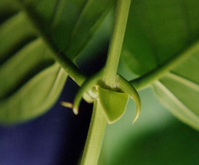- Uncaria tomentosa
Taxobox
name = "Uncaria tomentosa"

image_width = 240px
image_caption =
regnum =Plant ae
divisio = Magnoliophyta
classis =Magnoliopsida
ordo =Gentianales
familia =Rubiaceae
genus = "Uncaria "
species = "U. tomentosa"
binomial = "Uncaria tomentosa"
binomial_authority = (Willd. exSchult. ) DC. [cite web
url=http://sun.ars-grin.gov:8080/npgspub/xsql/duke/plantdisp.xsql?taxon=1972
title=Species Information
publisher=sun.ars-grin.gov
accessdate=2008-03-01
last=
first=]"Uncaria tomentosa" (popularly known in English as Cat's Claw, in Spanish as Uña de Gato or as indian name Vilcacora) is a woody vine found in the tropical jungles of South and Central America, which derives its name from its claw-shaped thorns. It is used as an
alternative medicine in the treatment of a variety of ailments.Biology
"Uncaria tomentosa" is a
liana deriving its name from hook-like thorns that resemble the claws of a cat. "U. tomentosa" can grow up to 30m tall, climbing by means of these thorns. The leaves are elliptic with a smooth edge, and grow in oppositewhorl s of two. Cat's claw is indigenous to theAmazon rainforest , with its habitat being restricted primarily to the tropical areas of South and Central America. There are two species of Cat's Claw, Uncaria tomentosa and Uncaria guianensis, each having different properites and uses. The two are frequently confused but U. tomentosa is the more heavily researched for medicinal use [Gattuso, M., Di Sapio, O., Gattuso, S. & Li Pereyra, E. (2004). Morphoanatomical studies of Uncaria tomentosa and Uncaria guianensis bark and leaves. "Phytomedicine, 11," 213–223.] and immune modulation, while U. guianensis may be more useful for osteoarthritis. [Piscoya J, Rodriguez Z, Bustamante SA, et al. Efficacy and safety of freeze-dried cat's claw in osteoarthritis of the knee: mechanisms of action of the species Uncaria guianensis. Inflamm Res. 2001;50:442–448.] U. tomentosa is further divided into twochemotype s with different properties and active compounds, a fact ignored by most manufacturers [Keplinger, K., Laus, G., Wurm, M., Dierich, M.P. & Teppner, Herwig. (1999). Uncaria tomentosa (Willd.) DC.—Ethnomedicinal use and new pharmacological, toxicological and botanical results. "Journal of Ethnopharmacology, 64," 23–34. Available on-line as a [http://www.samento.com.ec/sciencelib/sarticles/Uncaria81B4.pdf PDF] ] that can have significant implications on both its use as an alternative medicine and in clinical trials to prove or disprove its efficacy. [http://www.findarticles.com/p/articles/mi_m0GCU/is_n5_v14/ai_20097503 Nutrition Forum article by Varro E. Tyler on Cat's Claw] (Warning: pop-ups)]Medicinal uses
The parts used medicinally include the inner bark and root, taken in the form of capsules, tea and extract.
"U. tomentosa" is used in
nootropic drugs, as well as in treatment of cancer andHIV infection. It contains severalalkaloid s that are responsible for its overall medical effects, as well as tannins and various phytochemicals.Heitzman, M.E., Neto, C.C., Winiarz, E., Vaisberg, A.J. & Hammon, G.B. (2005). Ethnobotany, phytochemistry and pharmacology of Uncaria (Rubiaceae). "Phytochemistry, 66(1)", 5-29. PMID 15649507] The chemotype of the plant determines the dominant type of alkaloid it produces, and thus its properties "in vivo ". One chemotype has roots which produce mostly the pentacyclic alkaloids that are responsible for the immune-strengthening effects desired by most consumers. The second chemotype produces tetracyclic oxindole alkaloids known as rhynchophylline and isorhynchophylline which counteract the immune-strengthening actions of the pentacyclic alkaloids, reduces the speed and force of theheart 's contraction, and in high doses produceataxia , lack of coordination and sedative effects. Since "U. tomentosa" comes in at least these two different chemotypes, without chemical testing it is impossible to know which chemical compounds will predominate in a plant collected randomly from a natural setting.Some ingredients appear to act as anti-inflammatory, antioxidant and anticancer agents. As an herbal treatment, Cat's Claw is used to treat intestinal ailments such as Crohn's disease, gastric ulcers and tumors, parasites, colitis, gastritis, diverticulitis and leaky bowel syndrome, while manufacturers claim that "U. tomentosa" can also be used in the treatment of AIDS in combination with AZT, the treatment and prevention of arthritis and rheumatism, diabetes, PMS, chronic fatigue syndrome, prostate conditions, [ [http://www.nutrasanus.com/cats-claw.html NutraSanus article on Cat's Claw] ] immune modulation, [ [http://www.supplementwatch.com/suplib/supplement.asp?DocId=1070 Information on Cat's Claw] ]
Lyme disease [ [http://www.digitalnaturopath.com/data/cats_claw_controversy.html Treatment of Lyme disease with Cat's Claw] ] and systemic lupus erythematosus. [ [http://health.enotes.com/alternative-medicine-encyclopedia/cat-s-claw Cat's claw used to treat Lupus erythematosus] ] A 2005 review of the scholarly literature on Cat's Claw indicates there is supporting evidence toward its use in treating cancer, inflammation, viral infection and vascular conditions, and for its use as an immunostimulant, antioxidant, antibacterial and CNS-related agent.Indigenous use
The indigenous peoples of South and Central America have used "U. tomentosa" for medicinal purposes for two thousand years or more. Researchers have investigated the use of the plant by the Asháninka tribe of Peru, who use the plant as a general health tonic, contraceptive,
anti-inflammatory agent for the gastrointestinal tract, and as a treatment fordiarrhea , rheumatic disorders, acne, diabetes,cancer and diseases of the urinary tract. [ [http://www.longwoodherbal.org/catsclaw/catsclaw.PDF#search=%22Cat's%20Claw%20Ashaninka%20%222000%20years%22%22 The Longwood Herbal Task Force article on Cat's Claw] ]Allergies
Individuals
allergic to plants in theRubiaceae family and different species ofUncaria may be more likely to have allergic reactions to Cat's Claw. [ [http://www.intelihealth.com/IH/ihtIH/WSIHW000/8513/31402/347002.html?d=dmtContent#dangers Intelihealth article discussing uses and dangers of Cat's Claw] ] Reactions can includeitching ,rash and allergicinflammation of thekidneys . In one documented case, kidney failure occurred in a patient with Lupus erythematosus [Hilepo JN, Bellucci AG, Mossey RT. (1977). Acute renal failure caused by 'cat's claw' herbal remedy in a patient with systemic lupus erythematosus. "Nephron, 77(3)" pg. 361.] but it is not known if this was due to an allergic reaction or another cause.There are other plants which are known as cat's claw (or uña de gato) in Mexico and Latin America; however, they are entirely different plants, belonging to neither the Uncaria genus, nor to the Rubiaceae family. Some of the Mexican uña de gato varieties are known to have toxic properties.
Footnotes
References
* [http://www.ars-grin.gov/cgi-bin/npgs/html/taxon.pl?403273 Germplasm Resources Information Network: "Uncaria tomentosa"]
External links
* [http://www.uncariatomentosa.com/abstracts.php Webpage on Cat's Claw with a library of scientific abstracts organized by year]
* [http://sun.ars-grin.gov:8080/npgspub/xsql/duke/plantdisp.xsql?taxon=1972 "Uncaria tomentosa" List of Chemicals (Dr. Duke's Databases)]
Wikimedia Foundation. 2010.
